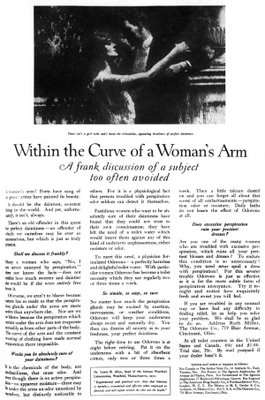T IMES may change, says the JWT News, but a good basic advertising appeal does not. A J. Walter Thompson advertisement for a deodorant, which appeared about 40 years ago, used the same type of illustration - a woman in a man's arms, her one arm upraised, and the same "You may offend without knowing it" appeal as is being used in today's modern "Fresh" (JWTNY) advertising.
James Young, who wrote the 1919 deodorant advertisement says that it was so startling at that time that some 200 Ladies' Home journal readers cancelled their subscriptions and "publishers begged us to stop the copy." Times have changed, but not basic advertising appeals. (Mr. Young adds a P.S.: "Several women who learned that I had written this advertisement said they would never speak to me again - that it was 'disgusting' and 'an insult to women.' But the deodorant's sales increased 11277 that year.")
You will learn more about James WW. Young in this book but nothing more important than his copy philosophy, as expressed to me in a letter from Rancho
"When I write an ad I first try to get in mind a very sharp conception of the kind of person I am going to talk to. Then I try to formulate, very clearly, the proposition I am going to make him or her - why he should buy something, think something, or do something.
"Then I try to think out where this person's interests or problems and the proposition come together, and from this try to work out the headline and main illustration which, as one unit, will take hold of them. I usually think out many headlines before I get the one which satisfies me. And also usually labor equally to get the one right illustration for the headline. Where possible, as in the Webb Young advertising, I test headlines for their relative effectiveness, knowing from these tests that some headlines can be twice as effective as others.
"As I write the body of the ad I keep thinking about the reader, asking myself: Have I made this clear? - What doubt will he have here? - Have I made this interesting ? - and so on.
"Some ads come easier than others, of course, but usually the actual writing process is not difficult for me. I do not begin it, as a rule, until I have clearly seen the completed ad in my own mind - headline, main illustration, format, and general course of the copy story. When that has come about, then I sit down and put it on paper, and the first draft usually stands, with few revisions."











